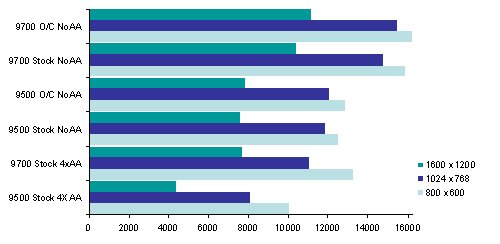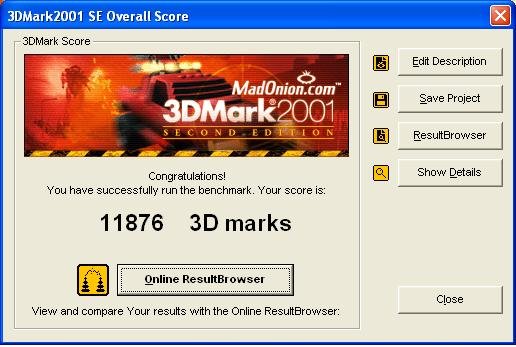Benchmarks I
In this review we have evaluated the R9500Pro's performance against the R9700Pro. Obviously the 9500 is not expected to keep up with the 9700, but how close will the performance difference be? Both cards were compared at their stock core and memory speeds, using default driver settings. Picture quality was then improved by running the tests again with 4x anti-aliasing.
Using Powerstip we were able to overclock the 9500Pro to stock 9700Pro speeds, quite an achievement representing a 50Mhz increase in core speed and a 40Mhz increase in RAM speed.
Stock speeds
- 9500Pro Core @ 275Mhz RAM @ 270Mhz (or 540Mhz as in dual mode)
- 9700Pro Core @ 325Mhz RAM @ 310Mhz (or 620Mhz as in dual mode)
Overclocked speeds
- 9500Pro Core @ 325Mhz RAM @ 310Mhz (620Mhz dual)
- 9700Pro Core @ 350Mhz RAM @ 325Mhz (650Mhz dual)
3DMark 2001 SE
3Dmark is one of the most widely used benchmarking programs in circulation today and is the ideal way of comparing your own performance against equipment we are reviewing for you. The tests carried out on the R9500 were performed using the default / official configuration i.e. 1024x768 resolution.

It is worth pointing out that the R9500 produced very high quality images in 3dmark. Motion was smooth throughout the tests.
The results are rather surprising. It was expected that the 9500 at stock speeds would not perform as well as the 9700 due to the 50Mhz difference in core speed and the 40Mhz difference in RAM speed. However a 2,500 difference seems a very large difference. Even running the 9500 at 9700 speeds (325Mhz core and 310Mhz Memory) there is a 2,200 points variance. Basically the 9500 is well behind the 9700's performance in 3dmark.
Pushing the 9700 to one side for a moment we should consider that benchmarks completed using a GeForce ti4600 earlier in the year produced 3dmark scores of circa 12,300 using a setup with a slightly faster FSB speed. With the 9500 at 11,900 the scores are relatively close between the 9500 and the GeForce 4600.










